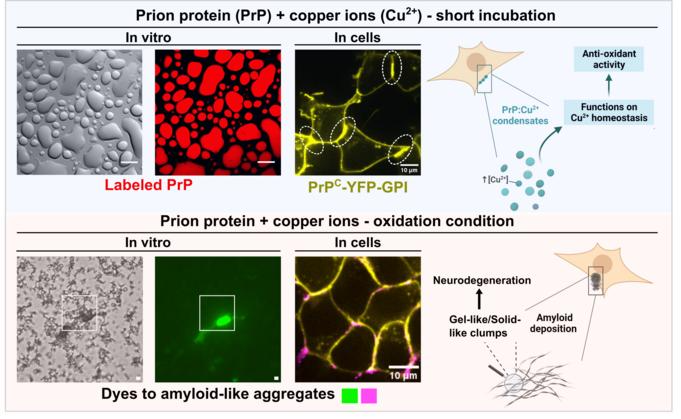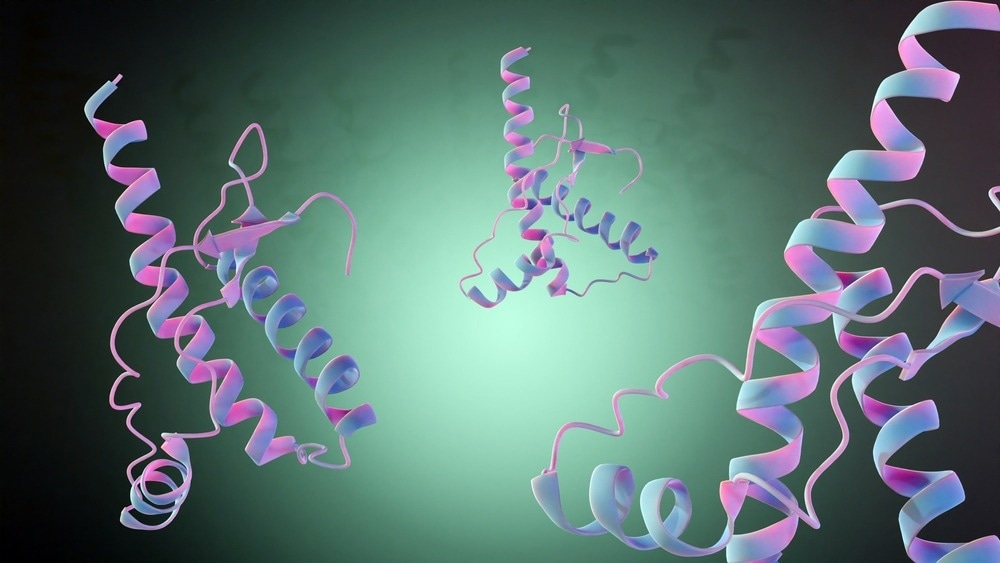Reviewed by Danielle Ellis, B.Sc.Dec 4 2023
In an innovative research article published in Science Advances, scientists from the Federal University of Rio de Janeiro (UFRJ) and the German Center for Neurodegenerative Diseases (DZNE-Berlin) illuminate the intricate interplay between the prion protein and copper ions in the physiopathology of live cells.
 The prion protein forms functional condensates that are enriched at cell-cell interfaces. However, long exposure to copper ions/hydrogen peroxide that result in oxidative stress, triggers a liquid-to-solid transition of condensates in vitro and in cells. Image Credit: Mariana Do Amaral/UFRJ.
The prion protein forms functional condensates that are enriched at cell-cell interfaces. However, long exposure to copper ions/hydrogen peroxide that result in oxidative stress, triggers a liquid-to-solid transition of condensates in vitro and in cells. Image Credit: Mariana Do Amaral/UFRJ.
The study lays the groundwork for potential treatments targeting clusters of copper-bound prion proteins, aiming to prevent abnormal solid formation and alleviate neurodegenerative consequences.
Analogous to oil droplets in water, cells house membrane-bound organelles pivotal for cellular function. This research contributes to unraveling a novel layer of complexity by exploring the existence of membraneless organelles or condensates, formed through phase separation. These protein-rich assemblies exhibit unique liquid-like properties and dynamic functions.
Significantly, proteins associated with neurodegenerative diseases undergo phase separation, hinting at a potential connection between liquid condensates and subsequent aggregation. The prion protein (PrP), linked to fatal brain disorders such as 'mad cow' disease, has long been recognized for its interaction with copper ions in brain cells.

Image Credit: Love Employee/Shutterstock.com
Under the leadership of Mariana Do Amaral, a graduate student supervised by Professor Yraima Cordeiro (UFRJ) and Professor Susanne Wegmann (DZNE-Berlin), the study reveals that PrP has the capacity to form dynamic liquid condensates at the cell surface. These condensates may potentially act as scavengers, regulating excessive copper ions within the cellular environment.
For over 20 years, research has hinted at copper binding to PrP and its role in abnormal folding. Our hypothesis was that PrP acts as a copper buffer via liquid-liquid phase separation, protecting cells from excess of copper.”
Do Amaral, Study First Author, Instituto Nacional De Ciência E Tecnologia De Biologia Estrutural E Bioimagem
The discoveries underscore the biological importance of liquid-liquid phase separation in PrP's regulation of copper homeostasis. The dynamic nature of PrP condensates, which accumulate copper ions, implies a finely tuned mechanism.
Intriguingly, exposure to oxidative stress—common in diseased or aging brains—prompted a shift from a liquid to a solid state, resembling the clumps associated with neurodegeneration.
This study not only enhances our comprehension of prion diseases but also unveils potential avenues for interventions targeting copper-bound prion protein condensates. Such interventions could prevent abnormal solid formation and alleviate the neurodegenerative consequences.
Employing advanced biophysical techniques, the research utilized methods like X-Ray photon correlation spectroscopy (XPCS) at the new Brazilian synchrotron light source (Sirius-LNLS) and live cell fluorescence recovery after photobleaching at Charité-University Medicine Berlin.
Journal reference:
do Amaral. M. J., et al., (2023) Copper drives prion protein phase separation and modulates aggregation. Science Advances. doi.org/10.1126/sciadv.adi7347.